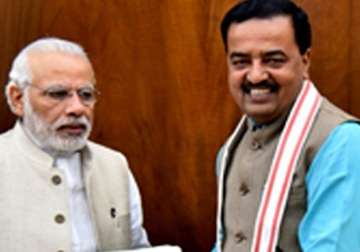In Uttar Pradesh, BJP to bank on Ram, Modi and Mayawati model
BJP is trying to emulate the model to regain lost glory in the country's most populous and politically critical state.
New Delhi: Almost 10 years after Mayawati's "social engineering" helped her BSP capture power in Uttar Pradesh, the BJP is trying to emulate the model to regain lost glory in the country's most populous and politically critical state.
"We sense strong anti-incumbency (against Samajwadi Party). There is also a substantial fall in Brahmin support for Mayawati. So we need to tap this vacuum," said a senior minister in the Narendra Modi government.
The appointment of Keshav Prasad Maurya, a Koeri caste OBC leader, as the Bharatiya Janata Party president in Uttar Pradesh, must be viewed from this standpoint, the minister said, outlining the agenda for next year's assembly elections.
The minister along with Prime Minister Modi, BJP president Amit Shah and senior leaders Rajnath Singh and Nitin Gadkari played a major role in the selection of Maurya, who replaced Laxmikant Bajpai.
Besides good caste combinations, the party is banking on the BJP's developmental plank and the appeal of Modi, an MP from Varanasi and also an OBC.
The BJP is also banking on the lingering Ram temple issue but wants to tread cautiously.
"We hope to make significant inroads among smaller caste groups like Gadhel, Kakushta, Jogi, Domri, Lodh and Nai," the BJP leader said. He felt these groups had been traditionally lost out on development. "So they see in BJP a party which will set the past wrongs right."
In the 2014 Lok Sabha battle, the Extremely Backward Class (EBCs) other than Yadavs, who largely remain with the Samajwadi Party, flocked to Modi and the BJP. "This needs to be retained," the leader said.
The BJP fought the 2014 election on its own but had a minor ally in Apna Dal, which represents the interests of the Kurmi community. Of the 80 Lok Sabha seats in UP, the BJP won a staggering 71 while the Apna Dal bagged two seats.
Rajnath Singh, an upper caste Thakur, was chief minister till March 2002. Prior to that, the party had a strong Lodh leader in chief minister Kalyan Singh.
But Kalyan Singh developed differences with then Prime Minister Atal Bihari Vajpayee and quit the BJP, denting its appeal in the key northern state. Rajnath Singh's rule also distanced Brahmins from the BJP.
BJP strategists feel that aggressive door-to-door canvassing to woo the Dalits and EBC voters by projecting Modi's OBC caste (Teli) will help - to consolidate a rainbow coalition a la Mayawati.
The BJP-led central government is already reaching out chiefly to farmers and rural India in the name of Dalit icon B.R. Ambedkar. The LJP of Food Minister Ram Vilas Paswan, a Dalit leader from Bihar, is keen to join the BJP bandwagon for the 2017 elections.
BJP's poll managers are also working overtime to make inroads among Muslims, who have generally backed either Maulayam Singh Yadav's Samajwadi Party or Mayawati's Bahujan Samaj Party.
"UP voters are very smart. Muslim voters in UP are smarter. They indulge in tactical voting and support strong candidates who can defeat BJP. This needs to be handled," said Jagdambika Pal, a BJP MP from UP.
But winning UP may not be that easy.
In 2012, the BJP finished third with just 47 seats in the 403-member assembly while the Samajwadi Party picked up 224 seats and the BSP, which was voted out, 80. The Congress was fourth with 28 seats.
The BJP's vote share was only 15 percent, down from 32.51 percent of 1996.
In September 2014, just four months after it swept the Lok Sabha polls, the BJP had suffered reverses in the assembly by-elections across key hubs like Bijnor, Thakurdwara, Nighasan, Hamirpur and Charkhari.
In 2002 also, the BJP was third with 88 seats with the Samajwadi Party topped a hung assembly with 143 seats followed by the BSP at 98. In 2007, Maywati's social engineering helped the BSP to win 206 seats followed by Samajwadi Party's 97 and BJP's 51.
